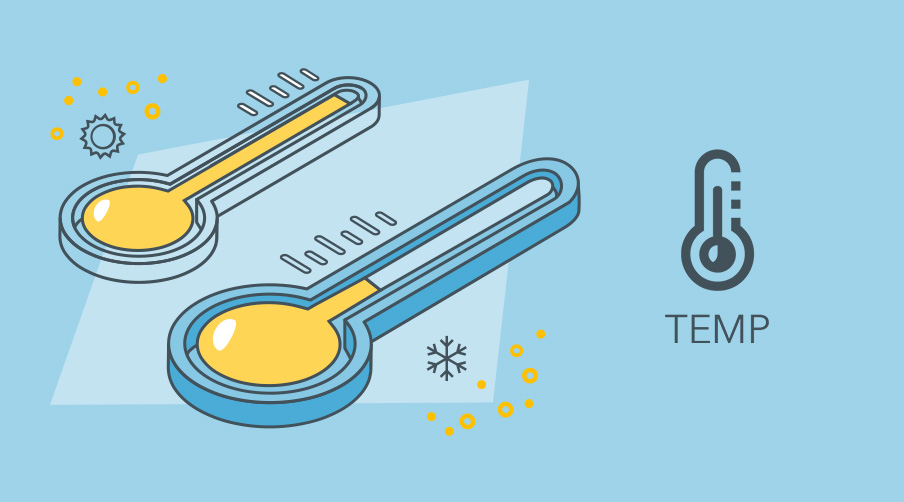How hot or cold it feels in a room can cause debates in every workplace.
Extreme temperatures are bad for wellbeing and productivity, reducing concentration and work performance. Heating and air conditioning are also major contributors for energy, impacting businesses operational costs. As people spend approximately 90% of their time indoors1, monitoring temperature is essential for commercial buildings like schools and offices.

Contents
What are the benefits of monitoring temperature in buildings?
Monitoring the temperature makes it easier to set the optimal levels for productivity, wellbeing, and tenant or employee satisfaction. It also increases control over energy costs, with data that allows you to use heating, ventilation, and air conditioning (HVAC) more efficiently.
One study from Cornell University2 found that, by setting the optimal temperature, they could:
- Reduce worker errors by 44%.
- Reduce energy consumption (by decreased cooling).
- Increase keying output by 150%.


Why should buildings monitor the temperature?
Facility Managers are often flooded with conflicting messages. "It's too hot on floor 2" but at the same time "there is a draft on floor 2". It can be quite perplexing. By monitoring, you can provide justifications for work orders and requests.
Moreover, too hot or too cold in offices and classrooms can lead to various undesirable effects for the building itself and its occupants, while at the same time raising business costs. Here is why commercial buildings should monitor temperature.
-
Improve satisfaction for building occupants:
 A comfortable indoor environment is one of the primary conditions for occupants to express satisfaction in buildings, especially offices.
A comfortable indoor environment is one of the primary conditions for occupants to express satisfaction in buildings, especially offices.
This has been confirmed by a survey of 16 office buildings in Germany. It found that the occupants’ control of the indoor climate strongly influenced their satisfaction with the indoor environment. 12 Monitoring indoor temperature helps you to make sure occupants leave the room satisfied rather than complaining that it felt either too cold or too warm.
-
Improve performance and productivity:
 Temperature is an important trigger for our ability to focus and perform both in the office and at school.
Temperature is an important trigger for our ability to focus and perform both in the office and at school.
In fact, one study has shown that by reducing classroom temperatures in late summer from 25 °C to 20 °C (77°F to 68°F), the performance of students significantly improved.3 Consistently, another study showed that performance levels in the office decreased by 15% when the temperature increased from 24.8 to 26°C (76.6°F to 78.8°F).4
Monitoring indoor temperature appears then vital for all commercial buildings to ensure the best levels of productivity and concentration.
-
Improve energy efficiency:
 Aside from lowering productivity levels, too high temperatures indoors can lead to additional costs for building owners.
Aside from lowering productivity levels, too high temperatures indoors can lead to additional costs for building owners.
Indeed, one study estimated that by maintaining the temperature in your offices within the optimal range, you could save around $330 per employee per year. 5
Thermostats that are not centrally located in a space, or that are placed near sources of drafts, heat or in direct sunlight, may not provide an accurate reading of temperature. By monitoring the temperature with appropriate sensors over time you get the chance to have total control on heating and energy expenditures.
-
Reduce asthma attacks and sick leave:
 Asthma has also been linked to changes in temperature, as sudden shifts from warm to cold can cause an asthma attack in some cases. 6
Asthma has also been linked to changes in temperature, as sudden shifts from warm to cold can cause an asthma attack in some cases. 6
Results of one study showed indeed that breathing in hot, humid air triggered an immediate increase in airway resistance in patients with mild asthma.7
Sick leave for asthmatics represents respectively up to 30% of the total cases of sick leave due to respiratory disorders. 8 This, of course, leads to costs for employers, which have been estimated to be 2.5 times higher ($5385 vs. $2121 for the control group, respectively).9 Controlling asthma triggers can then lead to huge savings for commercial buildings while at the same time improving occupants well being and satisfaction.
-
Don't waste energy whilst building's are unoccupied:
 When businesses close for bank holidays, or while they are under renovation, many may be willing to save electricity costs and reduce the environmental impact of wasted energy by lowering the temperature of the building and adjusting the HVAC system. Though this is sadly, often forgotten.
When businesses close for bank holidays, or while they are under renovation, many may be willing to save electricity costs and reduce the environmental impact of wasted energy by lowering the temperature of the building and adjusting the HVAC system. Though this is sadly, often forgotten.
It's important to strike the right balance too, as, when the temperature outside is significantly lower than usual, there is a risk that the indoor temperature will fall below 0°C (32°F) causing the water pipes to freeze. Cold causes severe stress in the structures of buildings and installations. Indeed, water pipes built into outside walls that normally remain frost-free are then in danger of freezing when outdoor temperatures drop between -20 and -30°C (between -4°F and -22°F).
Reducing the systems when unoccupied can save a vast amount of energy and costs. By monitoring remotely via the Airthings Dashboard or through the Airthings API you are empowered with full oversight into the building's temperature and more, and can adjust accordingly. 
By monitoring temperature remotely with Airthings sensors across multiple locations, it is possible to get an accurate picture of the indoor temperature in real time and take action immediately when needed.

Sources:
1 Harvard Annual review of public https://www.annualreviews.org/doi/10.1146/annurev-publhealth-031816-044420
2 http://ergo.human.cornell.edu/Conferences/EECE_IEQ%20and%20Productivity_ABBR.pdf
3 https://www.tandfonline.com/doi/abs/10.1080/10789669.2007.10390951
4 https://www.irbnet.de/daten/iconda/CIB6432.pdf
5 https://escholarship.org/uc/item/39s1m92c
6 https://getasthmahelp.org/indoor-air-quality.aspx Asthma Initiative of Michigan
7 https://www.ncbi.nlm.nih.gov/pmc/articles/PMC3373066/
8 https://pubmed.ncbi.nlm.nih.gov/11059951/
9 https://pubmed.ncbi.nlm.nih.gov/11842295/
10 https://epi.dph.ncdhhs.gov/oee/mold/grow.html
12 https://www.sciencedirect.com/science/article/abs/pii/S0378778807000588




 Asthma has also been linked to changes in temperature, as sudden shifts from warm to cold can cause an asthma attack in some cases. 6
Asthma has also been linked to changes in temperature, as sudden shifts from warm to cold can cause an asthma attack in some cases. 6 